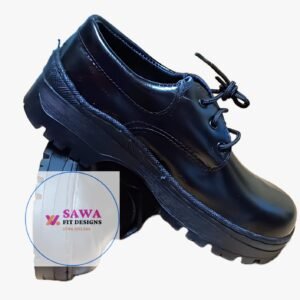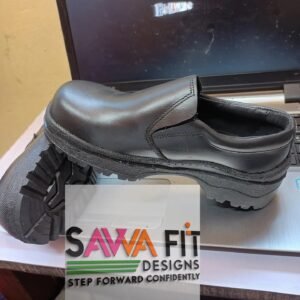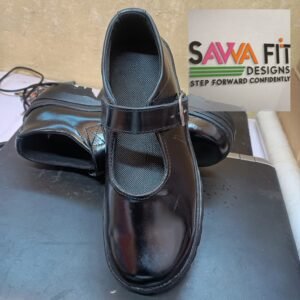Durable pure leather school shoes
-
Back to School Shoes -Genuine Pure Leather
Original price was: KSh1,300.KSh1,000Current price is: KSh1,000.Select options This product has multiple variants. The options may be chosen on the product pageClear3234242526272829303133 -
Boys Black School Shoes
Original price was: KSh1,500.KSh1,200Current price is: KSh1,200.Select options This product has multiple variants. The options may be chosen on the product pageClear363835373940 -
Slip-On School Shoes Boys
Original price was: KSh2,500.KSh2,000Current price is: KSh2,000.Select options This product has multiple variants. The options may be chosen on the product pageClear323436382728293031333537 -
Girls School Shoes (Buckle)
Original price was: KSh1,800.KSh1,400Current price is: KSh1,400.Select options This product has multiple variants. The options may be chosen on the product pageClear3837
Built to Last: The Enduring Value of Durable Pure Leather School Shoes
Choosing school shoes for your child is often more complicated than it seems. Kids are constantly on the go, from running in the playground to navigating busy school corridors. Their footwear takes a real beating, and you want shoes that can stand up to the challenge. This is where durable pure leather school shoes come in. They are not just a purchase; they are an investment in your child’s comfort, foot health, and your peace of mind.
Many parents find themselves in a cycle of replacing synthetic shoes every few months. While these might seem cheaper initially, the cost quickly adds up. Pure leather offers a different proposition. Its inherent strength, breathability, and ability to mold to the foot make it a superior choice for active school children. Let’s explore why genuine leather school shoes consistently outperform other materials and what to look for when buying a pair for your child.
Why Pure Leather Stands Out for School Shoes
Pure leather, unlike synthetic alternatives, provides a range of benefits that directly address the demands of school life.
- Exceptional Durability: School shoes face daily abuse. Scuffs, scrapes, puddles, and constant movement take their toll. Genuine leather is naturally robust and resilient. It resists tears and cracks far better than most synthetic materials. This means fewer replacements and a longer lifespan for the shoes. Think of it as a long-term solution. While the initial cost of durable pure leather school shoes might be higher, their extended wear often makes them more economical than repeatedly buying cheaper, less sturdy pairs. Many quality leather school shoes even come with guarantees, a testament to their expected longevity.
- Superior Comfort and Fit: Comfort is paramount for growing feet. Children spend hours in their school shoes, so discomfort can affect their concentration and overall well-being. Leather is a natural material that breathes, allowing air to circulate around the foot. This prevents heat and moisture buildup, which reduces the risk of blisters, odor, and fungal infections. Additionally, leather molds to the shape of the foot over time, creating a custom fit. This natural give reduces pressure points and rubbing, offering better support and comfort than rigid synthetic materials. This adaptability is particularly helpful for growing feet, as the shoes can subtly conform to changes in foot shape.
- Natural Breathability: One of leather’s significant advantages is its breathability. Active children generate heat and sweat. Synthetic materials often trap this moisture, leading to uncomfortable and unhealthy conditions for the feet. Leather allows for proper air circulation, keeping feet cooler and drier throughout the school day. This is a critical factor for preventing foot issues and maintaining good foot hygiene.
- Natural Water Resistance: While not entirely waterproof, pure leather offers a degree of natural water resistance. When you properly treat and maintain leather shoes with polishes or conditioners, they can repel light rain and puddles, keeping your child’s feet drier during unexpected downpours or playground adventures. This added protection helps extend the life of the shoes and keeps your child comfortable.
- Timeless Style: Leather school shoes often feature classic designs that remain appropriate for school uniforms year after year. Their rich texture and ability to develop a unique patina over time give them a sophisticated look. They look smart and presentable, contributing to a polished appearance for your child.
Genuine Leather vs. Synthetic: The Clear Choice
When you’re choosing school shoes, you’ll primarily find two material types: genuine leather and various synthetics. While synthetic options often look appealing due to a lower initial price, genuine leather offers significant advantages that often make it the better long-term investment for durable pure leather school shoes.
Genuine leather, being a natural material, possesses inherent strength and breathability. It’s built to withstand the rigors of active school life, adapting to the foot over time for comfort. Synthetics, on the other hand, are man-made and typically fall short in durability and breathability, often leading to quicker wear and less comfortable feet.
Here’s a breakdown of their key differences:
| Feature | Genuine Leather | Synthetic Materials |
| Durability | Highly durable, resists scuffs, tears, and cracking. | Less durable, prone to cracking, peeling, and wear. |
| Longevity | Lasts significantly longer; can endure a full school year or more. | Shorter lifespan; often needs replacement within months. |
| Breathability | Porous, allows air circulation, keeps feet cool and dry. | Less breathable, traps heat and moisture, can cause odor. |
| Comfort/Fit | Molds to foot shape over time for a custom, comfortable fit. | More rigid, less adaptable, can cause rubbing or discomfort. |
| Appearance | Rich, natural look; develops unique patina with age. | Can look uniform or “plastic-like”; wears unattractively. |
| Cost | Higher initial cost, but more cost-effective long-term due to longevity. | Lower initial cost, but higher overall cost due to frequent replacements. |
| Foot Health | Reduces moisture, less prone to blisters and fungal issues. | Can lead to sweaty feet, odors, and increased risk of foot issues. |
The Undeniable Advantages of Pure Leather for School Shoes
Pure leather offers specific benefits that make it ideal for the demanding environment of school.
Built for Toughness: Durability You Can Trust
School life is hard on shoes. Scuffs, scrapes, kicks, and general wear and tear are daily occurrences. Genuine leather is naturally strong and resilient. It holds up to damage much better than most synthetic materials. This translates to fewer replacements and a significantly longer lifespan for the shoes. Consider this a long-term investment. While durable pure leather school shoes might have a higher initial price, their extended wear often makes them a more cost-effective choice than repeatedly buying cheaper, less sturdy pairs. Many high-quality leather school shoes come with guarantees, which highlights their expected durability.
Comfort That Adapts: Supporting Growing Feet
Comfort is essential for children’s feet, especially as they grow. Kids spend many hours in their school shoes. Discomfort can affect their concentration and overall mood. Leather is a natural material that allows air to circulate, preventing heat and moisture buildup. This reduces the risk of blisters, unpleasant odors, and foot infections. Also, leather gradually molds to the foot’s shape, creating a custom fit. This natural flexibility reduces pressure points and rubbing, providing better support and comfort than rigid synthetic materials. This ability to adapt is especially helpful for growing feet, as the shoes can subtly conform to changes in foot shape.
Healthy Feet: The Breathability Factor
One of leather’s key benefits is its breathability. Active children generate heat and sweat. Synthetic materials often trap this moisture, leading to uncomfortable and unhealthy conditions for their feet. Leather allows proper air circulation, keeping feet cooler and drier throughout the school day. This is a critical factor for preventing common foot problems and maintaining good foot hygiene.
Everyday Protection: Natural Water Resistance
While not fully waterproof, pure leather offers some natural water resistance. If you properly treat and maintain leather shoes with polishes or conditioners, they can repel light rain and puddles. This keeps your child’s feet drier during unexpected showers or playground splashes. This added protection extends the shoes’ life and keeps your child more comfortable.
A Classic Look: Style That Lasts
Leather school shoes often feature classic designs that work well with school uniforms. Their rich texture and how they age uniquely give them a smart appearance. They look good and presentable, helping your child maintain a neat look for school.
Making the Right Choice: What to Look for in Durable Pure Leather School Shoes
When you are ready to purchase durable pure leather school shoes, consider these factors:
- Fit is Paramount: The most important factor is the fit. Poorly fitting shoes can cause blisters, bunions, and other foot problems. Always have your child try on shoes before buying. Make sure there is enough room for their toes to wiggle comfortably, but the heel should not slip. Also, check for good arch support.
- Quality of Leather: Look for full-grain or top-grain leather. Full-grain is the highest quality, known for its strength and breathability. Top-grain is also durable but slightly thinner. Avoid corrected-grain leather if durability is your main concern, as it often has a coating that can wear off.
- Sturdy Sole: A durable sole, typically made of rubber, offers good grip and shock absorption. Check that the sole is flexible enough for comfortable movement but thick enough to withstand daily wear. Look for anti-slip features for safety.
- Construction: Examine the stitching. It should be neat, strong, and even. Avoid shoes with visible glue or poorly finished seams. Quality craftsmanship contributes directly to durability.
- Lining: A breathable lining, ideally leather or a breathable mesh, helps keep feet dry and comfortable.
- Closure Type: Consider your child’s age and ability.
- Velcro/Hook-and-Loop: Easy for younger children to fasten themselves, promoting independence.
- Laces: Offer a more secure and adjustable fit, suitable for older children who can tie them.
- Buckles or Slip-ons: Provide different style options, but ensure they offer a secure fit.
- Padded Collar and Tongue: These features provide extra comfort around the ankle and reduce rubbing, which is helpful for active kids.
Caring for Your Durable Pure Leather School Shoes
To ensure your pure leather school shoes last as long as possible, follow these simple care tips:
- Clean Regularly: Wipe off dirt and mud with a damp cloth. For tougher grime, use a specialized leather cleaner.
- Polish and Condition: Regularly polish leather shoes to maintain their shine and protect the leather. Use a leather conditioner to keep the material supple and prevent cracking. This also helps with water resistance.
- Air Out Shoes: Let shoes air out after wear to prevent moisture buildup and odor. Avoid leaving them in direct sunlight or near heat sources, as this can dry out and crack the leather.
- Rotate Shoes: If possible, have more than one pair of school shoes and rotate them. This allows each pair to fully dry out and rest, extending their lifespan.
- Store Properly: Store shoes in a cool, dry place. Using shoe trees helps maintain their shape and absorb moisture.
Investing in durable pure leather school shoes is a smart decision for both parents and children. They offer comfort, support, and resilience that will see your child through countless school days, lessons, and playtime adventures. By choosing a quality pair and giving them proper care, you ensure your child has reliable, comfortable, and presentable footwear for the entire school year, and often beyond.
-
Back to School Shoes -Genuine Pure Leather
Original price was: KSh1,300.KSh1,000Current price is: KSh1,000.Select options This product has multiple variants. The options may be chosen on the product pageClear3234242526272829303133 -
Boys Black School Shoes
Original price was: KSh1,500.KSh1,200Current price is: KSh1,200.Select options This product has multiple variants. The options may be chosen on the product pageClear363835373940 -
Slip-On School Shoes Boys
Original price was: KSh2,500.KSh2,000Current price is: KSh2,000.Select options This product has multiple variants. The options may be chosen on the product pageClear323436382728293031333537 -
Girls School Shoes (Buckle)
Original price was: KSh1,800.KSh1,400Current price is: KSh1,400.Select options This product has multiple variants. The options may be chosen on the product pageClear3837
Durable pure leather school shoes



